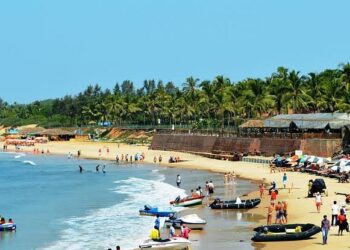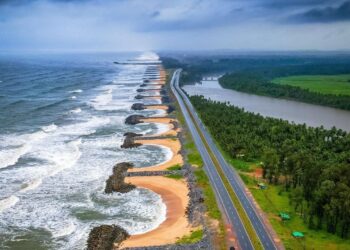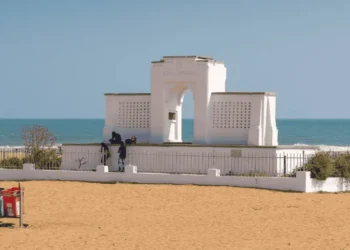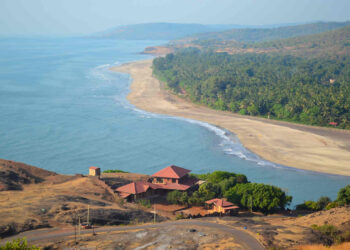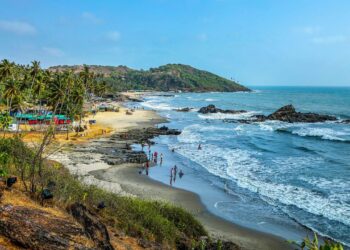The Varadvinayak Temple in Mahad, Raigad district, Maharashtra is dedicated to Lord Ganesha as Varadvinayak. Spanning roughly 1 acre, the temple was built by Peshwa General Ramji Mahadev Biwalkar in 1725AD. It is set by a serene lake near the Savitri River, about 80 km from Pune, and is the fourth temple to be visited in sequence of the Ashtavinayak temple Yatra.
Historical Overview
The Varadvinayak Temple is quite old, reaching back to the 14th century, however many say worship began much earlier. Mahad, a quiet town 80 km from Pune, was a spiritual spot. Old texts and local talk credit a devotee named Ramji Mahadev Biwalkar with building the temple in the early 1700s. The Peshwas, Maratha rulers who revered Ganesha, added halls and walls in the 1700s, as stone writings show. The temple faced damage during invasions in the 1600s, but devotees protected the Ganesha idol, hiding it in a nearby cave. It was rebuilt in the 1800s with help from local chieftains. From the 1900s, the Endowments Department maintained its sanctity, keeping its old charm. Today, it stands as a beacon of strong faith, drawing devotees and wanderers.
Mythological Importance
The legend regarding the temple says that, once Mukunda, wife of Rishi Vachaknavi happened to see Rukmangada, the handsome prince of Kaundinyapur. She was so enamored by the beauty of the prince that she asked him to fulfill her desires. But the prince who followed Dharma refused to make love to wife of another man. Indra, the king of Devas, happened to see the plight of Mukunda and took advantage of the situation. He appeared in the form of Prince Rukmangada and made love to Mukunda. In due course of time, Mukunda gave birth to a son named Gritsamada. He became a great scholar and defeated many scholars in debate. Gritasamada firmly believed that he was able to grasp the great scriptures as he was the son of Rishi Vachaknavi.
But once a Rishi refused to enter into debate with Gritasamada stating that he was not a true Brahmin. Gritsamada confronted his mother and she revealed to him that he was not the son of Rishi Vachaknavi but of Prince Rukmangada. Learning the circumstances of his birth, the raging Gritsamada cursed his mother to become the unattractive, thorny berry-bearing “Bhor” plant. Mukunda in turn cursed Gritsamada, that a cruel rakshas(demon) will be born from him. Suddenly they both heard a heavenly voice saying, “Gritsamada is the son of Indra”, leaving them both shocked, but too late to alter their respective curses. Grutsamad after getting cursed went to the forest of Pushpak and did intense tapas of Lord Ganesha. Pleased with his devotion, Ganpati appeared before him and granted him a boon that he would be considered a Brahmin and would bear a son who would not be defeated by anybody other than Lord Shiva. A temple was built at that very place and from thereon, Ganesha has been said to reside there in the form of Varada Vinayaka, the giver of bounty and success.
Temple Structure and Design
The Varadvinayak Temple in Mahad, Maharashtra, is crafted in the Hemadpanthi style, a 13th-century Maratha art, blending devotion with the town’s serene beauty. The temple sits by a peaceful lake, with a simple stone dome and thick walls. The gopuram, restored in the 1800s, stands proud with stone carvings of Ganesha with his trunk raised, sages praying, and lotuses, framed by vine patterns. Painted in soft cream and ochre, it’s capped with a simple kalasa that catches the morning light. The sanctum houses a black-stone Ganesha idol, draped in gold cloth and fresh garlands, set beneath a white-painted vimana, its stepped roof symbolizing purity. The sanctum’s walls, smoothed by time, carry faint Peshwa-era etchings of Ganesha’s tales, glowing under oil lamps.
Set near the Savitri River, the temple is reached by a short stone path from Mahad town, winding past neem and peepal trees. The courtyard, paved with uneven basalt, feels open yet sacred, fringed by old banyan trees that cast dappled shade. A small tank, fed by the nearby lake, is used for ritual dips, its edges carved with fish shapes, a Peshwa touch. The temple’s low walls, built from rough stone, have niches for Naga figures, believed to protect the grounds.
Rituals and Festivals
The Mahaganapati Temple in Ranjangaon vibrates with rituals honoring Lord Ganesha. The grandest festival, Bhadrapada Shuddha Chaturthi in August or September, celebrates Ganesha’s birth with modak offerings, mantra chants, and lamp-lit processions. Priests perform Maha Puja, bathing the idol in milk. Magha Shuddha Chaturthi in January or February features a havan with sesame seed offerings for prosperity. Monthly Sankashti Chaturthi sees devotees fasting and lighting lamps to overcome obstacles. Daily rituals include Mangal Aarti at dawn with hymns, Panchamrit Abhishekam for the idol’s bath, and Shej Aarti at night. Unique to Ranjangaon, Laddu Archana on Tuesdays involves offering 21 laddoos for wealth. The temple’s Annadan program serves free meals on festival days, and a stall offers prasad of coconut and jaggery, binding devotees to Ganesha’s grace.
How to Get There:
Air: Pune International Airport, 80 km away, is nearest. Taxis take 2 hours, costing 2000-3000 rupees.
Train: Khopoli Railway Station, 25 km away, links to Pune (1.5 hours) and Mumbai (2 hours). Autos to Mahad cost 300-500 rupees.
Road: Mahad is 80 km from Pune. Buses from Pune’s Swargate Bus Stand (2 hours) stop at Mahad town, 1 km away. Autos cost 20-40 rupees.
Best Time to Visit: October to March has good weather, 20-30°C. Weekdays are calm. Ganesh Chaturthi packs crowds, so book early.
Nearby Attractions: Ballaleshwar Temple, 50 km away in Pali, is the fourth Ashtavinayak stop. Raigad Fort, 40 km away, is a historic Maratha stronghold. Mahabaleshwar, 70 km away, offers scenic hill views.

